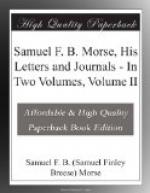Benjamin West.—George III.—Morse begins his studies.—Introduced to West.—Enthusiasms.—Smuggling and lotteries.—English appreciation of art.—Copley.—Friendliness of West.—Elgin marbles.—Cries of London.— Custom in knocking.—Witnesses balloon ascension.—Crowds.—Vauxhall Gardens.—St. Bartholomew’s Fair.—Efforts to be economical.—Signs of war.—Mails delayed.—Admitted to Royal Academy.—Disturbances, riots, and murders.
At this time Benjamin West the American was President of the Royal Academy and at the zenith of his power and fame. Young Morse, admitted at once into the great man’s intimacy through his connection with Washington Allston and by letters of introduction, was dazzled and filled with enthusiasm for the works of the master. He considered him one of the greatest of painters, if not the greatest, of all times. The verdict of posterity does not grant him quite so exalted a niche in the temple of Fame, but his paintings have many solid merits and his friendship and favor were a source of great inspiration to the young artist.
Mr. Prime in his biography of Morse relates this interesting anecdote:—
“During the war of American Independence, West, remaining true to his native country, enjoyed the continued confidence of the King, and was actually engaged upon his portrait when the Declaration of Independence was handed to him. Mr. Morse received the facts from the lips of West himself, and communicated them to me in these words:—
“’I called upon Mr. West at his house in Newman Street one morning, and in conformity with the order given to his servant, Robert, always to admit Mr. Leslie and myself, even if he was engaged in his private studies, I was shown into his studio.
“’As I entered, a half-length portrait of George III stood before me upon an easel, and Mr. West was sitting with back toward me copying from it upon canvas. My name having been mentioned to him, he did not turn, but, pointing with the pencil he had in his hand to the portrait from which he was copying, he said:—
“’"Do you see that picture, Mr. Morse?”
“’"Yes sir!” I said; “I perceive it is the portrait of the King.”
“’"Well,” said Mr. West, “the King was sitting to me for that portrait when the box containing the American Declaration of Independence was handed to him.”
“’"Indeed,” I answered; “what appeared to be the emotions of the King? what did he say?”
“’"Well, sir,” said Mr. West, “he made a reply characteristic of the goodness of his heart,” or words to that effect. “’Well, if they can be happier under the government they have chosen than under mine, I shall be happy.’"’”
On August 24, 1811, Morse writes to his parents:—




